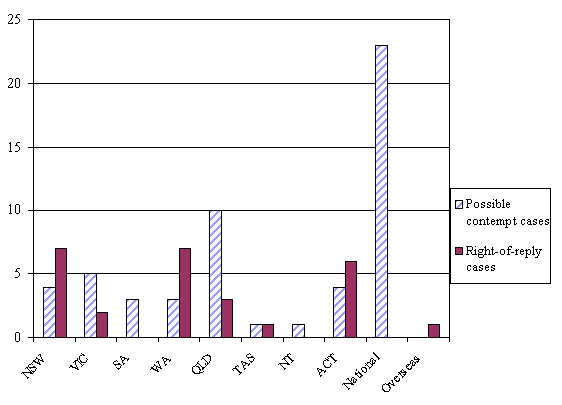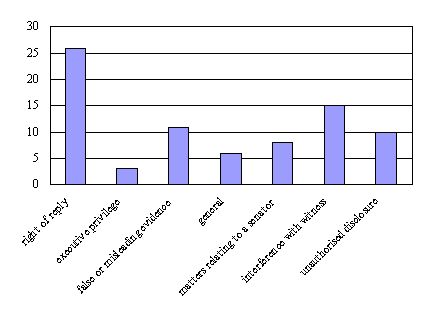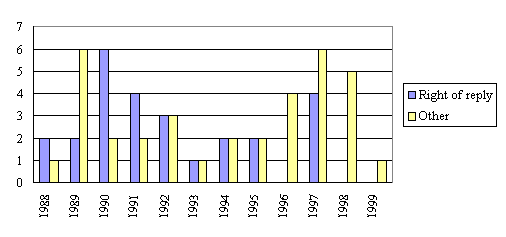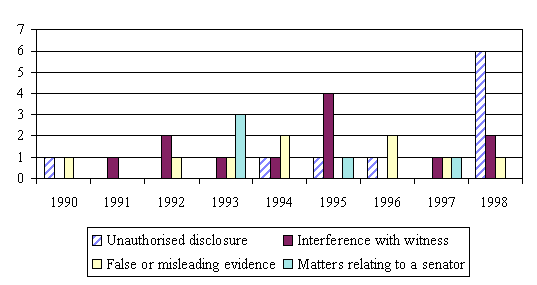APPENDIX E
WORK OF COMMITTEE OF PRIVILEGES: SOME FACTS AND FIGURES
References
Since 1966, 87 matters have been referred to the Committee of Privileges.
On three occasions, the committee reported on related references within
the one report. Two matters were reported on in reports nos. 43 and 50,
and six matters were covered in report no. 74. On two other occasions,
references lapsed at the termination of a Parliament and were not pursued
by the incoming committee in the new Parliament. These latter references
have been excluded from all subsequent analysis. In the committee's first
general report (no. 35), it reported on four right-of-reply matters which
were not proceeded with or which were resolved in another fashion. A further
matter not proceeded with was mentioned in the 62nd report, while this
current report advises of a right-of-reply matter which the committee
refused to consider.
Geographic source of references
References may be sourced from more than one location. As shown in Fig.
E.1, the majority of the committee's references since February 1988 have
come from 'national' sources. That is, they were generated partly or solely
from federal government departments or agencies, or involved senators,
or committees considering estimates.
Figure E.1: Source of references 1988-1998

Two states, New South Wales and Western Australia, have been the source
of the greatest number of right-of-reply references, while Queensland
has generated most of the state-sourced contempt cases.
Public Service involvement
Since the committee's inception, of the 44 references broadly categorised
as involving possible contempt, 22 have involved federal or state public
servants or statutory office-holders. Cases have been divided fairly equally
between departmental public servants and officers in statutory authorities.
The references involving public servants or statutory office-holders have
been spread across a wide range of subject areas, including defence, customs,
Aboriginal affairs, health, criminal justice, telecommunications and business
law. Nine cases involved the possible giving of false or misleading evidence;
nine involved possible threat or penalty to a witness; four the unauthorised
disclosure of information; one involved, in part, possible misrepresentation
of committee proceedings, while one was an executive privilege matter.
[1]
Conduct of inquiries
On receiving a reference, the Committee of Privileges normally seeks,
in writing, input from the persons involved. It provides them with all
relevant evidence and invites a response. Such responses often elicit
more questions from the committee, which seeks to answer them by providing
the further documentation it has received from the complainant to other
persons involved, and vice versa, and inviting further written submissions.
Claim and counterclaim can be traded through the committee until it is
satisfied that it has sufficient reliable evidence on which to reach its
conclusions. In the event that the committee feels it needs to hear evidence
in person from the persons involved, it will invite them to a public hearing.
This is the exception, however, rather than the rule. Since its inception,
the committee has held public hearings into 11 matters, involving 19 days
of public hearings. Eight of the matters involved possible contempt. In
more than three-quarters of possible contempt cases, the committee has
not found it necessary to take oral evidence.
The length of time taken by the committee to complete an inquiry depends
on a number of factors: the inherent complexity of the reference; the
number of references under consideration simultaneously; the promptness
of responses from participants; the interruptions brought about by parliamentary
elections; the vagaries of the parliamentary calendar; and the type of
reference. From reference to report, the committee's inquiries have ranged
in time taken from one day ( Reports nos 34 and 38) to 25 months (Report
no. 67). The average duration of right-of-reply references has been 40
days, with 18 being completed within one month and 8 within one week.
Right-of-reply cases can generally be handled swiftly, with the co-operation
of the person seeking to make a response. References which involve public
hearings tend to take a little longer to finalise than others – averaging
9 months as opposed to 7.9 months.
Reports
Between its establishment and the end of May 1999, the committee tabled,
or presented to the President, 75 reports. Ten were tabled in the years
between 1966 and the passage of the Parliamentary Privileges Act 1987
and the Senate Privilege Resolutions on 25 February 1988;
65 have been tabled in the 11 years since.
Figure E.2: No. of reports tabled per year, 1988 - May 1999

The committee's activities prior to 1988 were spasmodic, with little
or no 'bunching' of reports: reports were tabled in 1971, 1975, 1978,
1979 (2), 1981, 1984, 1985 (2) and 1986. Since 1988, however, many more
demands have been placed on the committee. The busiest year to date has
been 1995, during which nine privilege reports were tabled. Reports can
encompass more than one reference, with report no. 74, for example, covering
six references.
Not only has the committee tabled more reports but it has had fewer breaks
between references. Since November 1988 the committee has not been without
a reference and at times has had as many as ten active references.
The 75 reports tabled or presented between 1966 and the end of May 1999
can be categorised as follows:
Figure E.3: Types of reports, 1966-May 1999

A number of reports fall into more than one category: 26 dealt with right-of-reply
cases; 15 with possible threats or penalties to witnesses; 10 with unauthorised
disclosure of committee documents or draft reports; 11 with false or misleading
information supplied to the Senate or a Senate committee; 8 with matters
relating to senators (harassment, threats, etc); 3 with executive privilege;
and 6 with general matters.
The largest category by far is the 26 right-of-reply reports, constituting
34 per cent of reports tabled. After a peak of six right-of-reply reports
in 1990, as Figure E.4 shows, the number of these cases seems to have
stabilised.
Figure E.4: Comparison of numbers of right-of -reply reports and others

Despite their dominance in terms of overall numbers, right-of-reply matters
do not constitute a significant workload for the committee. Such matters
tend to be relatively quick for the committee to deal with, as it does
not investigate the facts of the matter but simply enables persons to
counter what they perceive to be inaccuracies voiced about them in the
Senate chamber. If the right-of-reply references initiated but not pursued
to finality by the complainant are excluded, 18 of the 26 right-of-reply
cases took less than a month from reference to tabling, while eight took
less than a week.
Contempt inquiry findings
When the references dealing with possible contempts are considered, it
is interesting to note the changes over time in the types of contempt
involved. As Figure E.5 shows, in the 1990s there has been a fluctuating
number of cases in which persons giving information to a senator or a
Senate committee have alleged that they have been threatened with some
form of reprisal or have been penalised in some way for giving or preparing
to give such information or evidence. Unauthorised disclosures featured
strongly in 1998, with the one report tabled featuring six cases.
Figure E.5: References by contempt type

Since the inception of the committee, contempt has been found in 12 cases,
or in approximately a quarter of the possible contempt cases, although
the perpetrator has not always been identified.
Footnotes
[1] Some references have covered more than one
possible contempt.